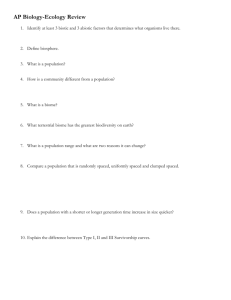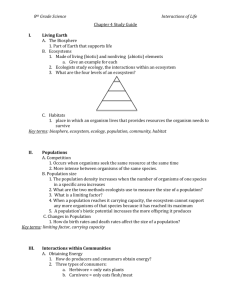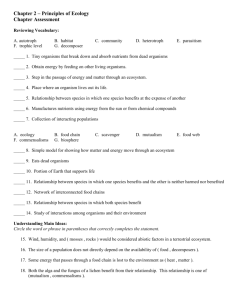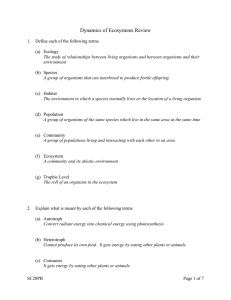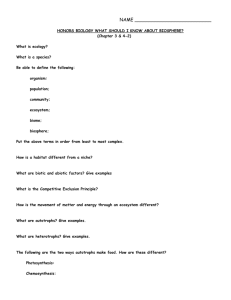Ecology Objective Sheet
advertisement
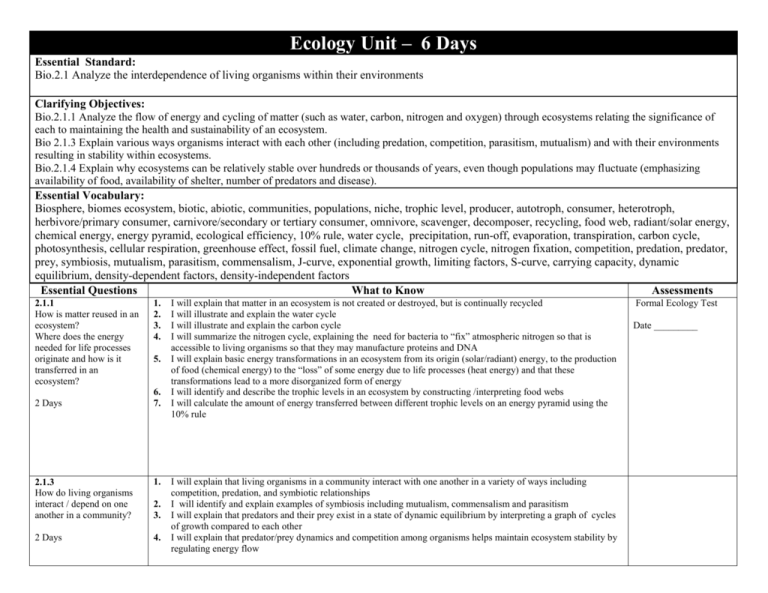
Ecology Unit – 6 Days Essential Standard: Bio.2.1 Analyze the interdependence of living organisms within their environments Clarifying Objectives: Bio.2.1.1 Analyze the flow of energy and cycling of matter (such as water, carbon, nitrogen and oxygen) through ecosystems relating the significance of each to maintaining the health and sustainability of an ecosystem. Bio 2.1.3 Explain various ways organisms interact with each other (including predation, competition, parasitism, mutualism) and with their environments resulting in stability within ecosystems. Bio.2.1.4 Explain why ecosystems can be relatively stable over hundreds or thousands of years, even though populations may fluctuate (emphasizing availability of food, availability of shelter, number of predators and disease). Essential Vocabulary: Biosphere, biomes ecosystem, biotic, abiotic, communities, populations, niche, trophic level, producer, autotroph, consumer, heterotroph, herbivore/primary consumer, carnivore/secondary or tertiary consumer, omnivore, scavenger, decomposer, recycling, food web, radiant/solar energy, chemical energy, energy pyramid, ecological efficiency, 10% rule, water cycle, precipitation, run-off, evaporation, transpiration, carbon cycle, photosynthesis, cellular respiration, greenhouse effect, fossil fuel, climate change, nitrogen cycle, nitrogen fixation, competition, predation, predator, prey, symbiosis, mutualism, parasitism, commensalism, J-curve, exponential growth, limiting factors, S-curve, carrying capacity, dynamic equilibrium, density-dependent factors, density-independent factors Essential Questions What to Know Assessments 2.1.1 How is matter reused in an ecosystem? Where does the energy needed for life processes originate and how is it transferred in an ecosystem? 2 Days 1. 2. 3. 4. 5. 6. 7. 2.1.3 How do living organisms interact / depend on one another in a community? 1. 2 Days 4. 2. 3. I will explain that matter in an ecosystem is not created or destroyed, but is continually recycled I will illustrate and explain the water cycle I will illustrate and explain the carbon cycle I will summarize the nitrogen cycle, explaining the need for bacteria to “fix” atmospheric nitrogen so that is accessible to living organisms so that they may manufacture proteins and DNA I will explain basic energy transformations in an ecosystem from its origin (solar/radiant) energy, to the production of food (chemical energy) to the “loss” of some energy due to life processes (heat energy) and that these transformations lead to a more disorganized form of energy I will identify and describe the trophic levels in an ecosystem by constructing /interpreting food webs I will calculate the amount of energy transferred between different trophic levels on an energy pyramid using the 10% rule I will explain that living organisms in a community interact with one another in a variety of ways including competition, predation, and symbiotic relationships I will identify and explain examples of symbiosis including mutualism, commensalism and parasitism I will explain that predators and their prey exist in a state of dynamic equilibrium by interpreting a graph of cycles of growth compared to each other I will explain that predator/prey dynamics and competition among organisms helps maintain ecosystem stability by regulating energy flow Formal Ecology Test Date _________ 2.1.4 How do communities change over time? What limits the size of a population of organisms? 5. 6. 7. 8. 2 Days I will graph/interpret graphs of populations showing unlimited exponential growth (J-curve) and graphs showing stabilization following a period of exponential growth (S-curve) I will explain that the carrying capacity for a population is determined by environmental limits I will identify density-dependent and density-independent limiting factors for a specific population including diseases and evaluate the impact of a disease epidemic I will explain that populations fluctuate around the carrying capacity in a state of dynamic equilibrium

